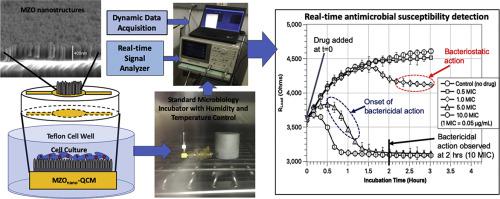Journal of Microbiological Methods ( IF 1.7 ) Pub Date : 2020-10-02 , DOI: 10.1016/j.mimet.2020.106071 Yifan Wu 1 , Guangyuan Li 1 , Yuzhi Hong 2 , Xilin Zhao 2 , Pavel Ivanoff Reyes 1 , Yicheng Lu 1

|
We report a dynamic and rapid detection of the response of S. epidermidis to various antimicrobial treatments utilizing the real-time spectral amplitude modulations of the magnesium zinc oxide nanostructure-modified quartz crystal microbalance (MZOnano-QCM) biosensor. The sensor consists of a quartz crystal microbalance (QCM) with magnesium zinc oxide (MZO) nanostructures grown directly on the sensing electrode using metalorganic chemical vapor deposition (MOCVD). Combining the high sensitivity detection of bacteria provided by the MZO nanostructures with the QCM's dynamic acoustic spectrum makes a highly-sensitive dynamic biosensor well-suited for monitoring viscoelastic transitions during drug treatment compared to the QCM's conventional frequency shift signals. We demonstrated dynamically monitoring the response of S. epidermidis to various concentrations of the drug ciprofloxacin, and response to three different antimicrobials vancomycin, oxacillin, and ciprofloxacin, using spectral amplitude modulations of the MZOnano-QCM. Our results indicate that the amplitude modulations exhibit high sensitivity to S. epidermidis response to different drug treatments compared to the conventional frequency shift signals of the device, allowing for rapid determination (within 1.5 h) of the efficacy of the antimicrobial drug. The high sensitivity demonstrated by the spectral amplitude modulations is attributed to the direct relationship of these signals to the viscoelastic transitions of the bacterial cells on the device's sensing area while responding to drug treatment. This relationship is established by the Butterworth-Van-Dyke (BVD) model of the MZOnano-QCM. Standard microbiological protocols and assays were performed to determine the optimal drug dosages and the minimum inhibitory concentrations to serve as the benchmark for the sensor data.
中文翻译:

使用 MZO 纳米结构改性石英晶体微天平中的光谱幅度调制快速动态检测抗菌治疗反应
我们报告了利用氧化镁锌纳米结构改性石英晶体微天平(MZO nano -QCM)生物传感器的实时光谱幅度调制动态快速检测表皮葡萄球菌对各种抗菌治疗的反应。该传感器由石英晶体微天平 (QCM) 和使用金属有机化学气相沉积 (MOCVD) 直接在传感电极上生长的氧化镁锌 (MZO) 纳米结构组成。与 QCM 的传统频移信号相比,将 MZO 纳米结构提供的细菌高灵敏度检测与 QCM 的动态声谱相结合,使高灵敏度动态生物传感器非常适合监测药物治疗期间的粘弹性转变。我们演示了使用 MZO nano -QCM 的光谱幅度调制动态监测表皮葡萄球菌对不同浓度药物环丙沙星的反应,以及对三种不同抗菌药物万古霉素、苯唑西林和环丙沙星的反应。我们的结果表明,与设备的传统频移信号相比,振幅调制对表皮葡萄球菌对不同药物治疗的反应表现出高敏感性,从而可以快速确定(1.5 小时内)抗菌药物的功效。光谱幅度调制所表现出的高灵敏度归因于这些信号与设备传感区域上的细菌细胞在响应药物治疗时的粘弹性转变的直接关系。这种关系是由 MZO纳米QCM 的巴特沃斯-范戴克 (BVD) 模型建立的。 执行标准微生物学方案和测定以确定最佳药物剂量和最低抑制浓度,作为传感器数据的基准。











































 京公网安备 11010802027423号
京公网安备 11010802027423号